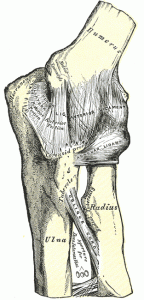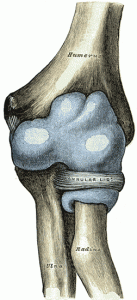There are number of elbow injuries that result from a combination of muscle and tendon problems in the forearm. Medial epicondylitis is similar to lateral epicondylitis as it is also an inflammation of the tendons and muscles along the inner forearm, particularly where they attach at the medial epicondyle. The condition is caused by motions involving repetitive bending of the forearm in toward the body with the wrist flexed as in a golf swing or a baseball pitch.
Anatomy of the Elbow

The muscles on the palm side of the forearm, called wrist flexors, pull the wrist down. They begin at a common flexor tendon attachment on the inside bump of the elbow called the medial epicondyle. As the wrist is flexed or the hand forms a grip, these muscles tighten and pull on the tendons. During a golf swing, force is put on the flexor muscles and the tendons that attach these muscle to the medial epicondyle in the elbow.
How the Elbow Works
The elbow is the joint formed where the humerus—the single bone in the upper arm—meets the two bones of the forearm—the radius and ulna. You can identify the radius and ulna by holding your hand in the thumbs up position. The radius is the upper bone and the ulna is the lower bone. The olecranon is the bony tip of the elbow and is part of the ulna. At the lower part of the humerus, there are two bony knobs—one on the inside (medial) and one on the outside (lateral)—called epicondyles.
The elbow is made up of 3 joints:
• the radiohumeral joint – where the radius meets the humerus
• the ulnohumeral joint – where the ulnar meets the humerus
• the superior radioulnar joint – where the radius meets the ulna
The ends of the bones in all of these joints are covered with articular cartilage to help with the smooth movement in these joints. These joints allow the elbow to act like a hinge—bend and straighten—and allows the forearm to rotate without moving the upper arm.
The muscles in the upper and lower arm work together to align, move and keep the elbow stable. The more important muscles are the biceps and the brachials which are located in the front of the upper arm, and the triceps and aconeus in the back of the upper arm. Tendons are the flexible fibrous tissues that connects muscles to bones—in this case to the radius, ulna and humerus.

The joint capsule, which is made up of tough fibrous bands that surround the joint and ligaments that connect the bones to each other, serve to make the elbow more stable. The two major ligaments are the medial collateral ligament and the lateral collateral ligament. These two ligaments run from the epicondyles to the upper ulna and upper radius. The annual ligament encircles the upper radius.
The median, ulnar, and radial nerves run the length of the arm and cross at the elbow. Each of the nerves acts on specific muscles to contract the arm and hand and to perceive pain, touch and temperature. Sometimes nerve symptoms in the hand can be an indication of a problem in the elbow.
The olecranon bursa is a fluid filled sac at the tip of the elbow. It cushions the joints and reduces friction between non-bony tissues. The synovial membrane inside the joint capsule makes synovial fluid which lubricates the elbow joints.
The elbow is part of the upper limb which starts at the neck, shoulder and upper arm and goes down to the forearm, wrist and hand. All of these parts work together and need each other for function and movement.
Causes of Medial Epicondylitis
Over time, the repeated stress can cause the tendons to stretch or tear away from the bone, causing pain. These injuries begin to heal by forming scar tissue, but each time the muscles are stressed the tendons are re-injured. This chronic re-injury may cause the healing process to simply stop before mature scar tissue is formed. Immature scar tissue remains weak and painful. Re-injury can happen during strains from certain repetitive movements like those during shoveling, gardening, or swimming.
Symptoms of Medial Epicondylitis
Symptoms include pain and tenderness at the medial epicondyle, and the pain gets worse when the wrist is flexed. The pain may spread down the forearm. Activities that use the flexor muscles to bend the wrist or grasp objects can make the injury worse.
Diagnosis of Medial Epicondylitis
Medial epicondylitis is usually diagnosed by physical examination alone. Tenderness in the area of attachment of the medial flexor tendons and pain with use of the flexor muscles are the main symptoms. Sometimes medial epicondylitis has the same symptoms of a pinched ulnar nerve found with cubital tunnel syndrome. Nerve tests may be needed to determine which problem you have.
Prevention and Treatment for Medial Epicondylitis
Self Treatment:
Treatment begins with first aid including R.I.C.E.:
• Ice: Ice decreases the size of blood vessels in the sore area which reduces inflammation and relieves pain. Ice can be applied with cold packs, ice packs, or ice massage. Ice massage is an easy and effective way to provide first aid. Simply freeze water in a paper cup. To apply, tear off the top inch of the paper cup exposing the ice. Rub the ice for 3-5 minutes over the sore area until it’s numb.
• Rest: Resting the elbow can prevent further injury and allow your elbow time to heal. An inelastic sling can rest the elbow by spreading forces from the wrist over a larger area of the elbow. A neutral wrist splint holds the wrist in a safe position, limiting stress on the elbow. Immobilizing your fingers can limit possible strains on new scar tissue. Pain with activity is a sign that irritation is occurring. Whenever possible, don’t do movements that increase pain.
• Specific rest: Slowly doing range-of-motion exercises of the wrist, forearm, and elbow will keep these joints from getting stiff while preventing further injury to the elbow. Stop doing the exercises if they cause pain.
- Wrist: Move your hand up and down.
- Forearm: Turn your forearm up and down.
- Elbow: With your forearm on a smooth surface, slowly bend and straighten the elbow.
• Isometrics: With isometric exercises, the muscle tightens but there is no movement in the joint. Resistance is applied with the joint in a neutral position, either at the limits of motion, or at various angles in between. Don’t do these exercises if they cause pain.
•
- Multiwrist: Put light resistance with the opposite hand while trying to move the wrist either up, down, or side to side.
- Forearm: Holding the forearm with the opposite hand, try to turn the forearm either up or down.
- Elbow: Without allowing moving your elbow, try bending the elbow up and then down.
Anti-inflammatory medications prescribed by your doctor work well along with putting ice on the sore area and resting your elbow.
Supervised Treatment (physical therapy)
Following an evaluation, treatment may start with anti-inflammatory medicine. Several treatments are available to limit the inflammation and pain from medial epicondylitis. Treatments include ice, heat, iontophoresis, TENS, ultrasound, or phonophoresis.
The presence of golfer’s elbow may be due to not enough blood flow in the area. Ways to increase blood flow to the area include heat, ultrasound, friction massage, and soft tissue massage.
To help break the cycle of inflammation and scarring, treatment is focused on keeping the scar tissue pliable so it can stretch which keeps it from tearing each time the elbow is straightened or the wrist tendons are used. Treatment choices include friction massage, forearm stretching, soft tissue massage, and manipulation.
As the elbow heals various types of exercises are used. At first, isometrics help maintain muscle mass without over stressing tissue. Later, progressive resistive exercises are used to increase endurance and strength. As the pain goes away, exercises will focus on the wrist extensors. These muscles need to be able to control the forces that would cause these muscles and tendons to lengthen. Key areas of for strengthening are wrist, forearm, and elbow. As your overall strength returns, hand exercises may be added to the routine.
Medical Treatment
Splinting of the elbow, wrist and fingers for a short time can limit movement and stress on the flexor muscles. Further problems can be avoided by taking frequent breaks at work or play, improving the overall condition of your arm muscles, and limiting heavy pushing, pulling or grasping. Anti-inflammatory medications such as aspirin or ibuprofen can be used to reduce inflammation. A cortisone injection may reduce the inflammation and pain.
Surgery
If conservative treatment fails, surgery can be done to treat golfer’s elbow. The tendons that attach to the medial epicondyle are released and allowed to loosen a bit. The tendons are split to reveal the area of angiofibroblastic tendinosis. The injured tissue is removed, and if any bone spurs have formed on the medial epicondyle these are also removed. The surgery provides fresh, healthy bone for the tendon to reattach itself. Careful attention is paid to the ulnar nerve, to ensure there is no compression on the nerve. If the nerve is not involved, the split in the tendon is then stitched together. It usually takes about 3 months for maximal healing after the elbow is repaired.